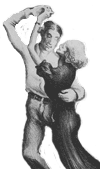 |
ROUND DANCING — CHOREOGRAPHED BALLROOMEDUCATIONAL ARTICLESMAJOR SECTIONS: Figures | Articles | Links | Alph. Index | Search | Home |
|
|
Leading An Underarm Turnby Harold & Meredith Sears In round dancing, the woman rotates a lot more than the man. She gets to do most of the turns and the spirals, and he leads these by raising his lead hand. Get the arm up before the turn. Keep it up and centered over her head during the turn. Then, bring it down when the rotation is over, to signal the end of the figure. We men are often tempted to lead a turn by making a circular movement with the lead hand — by whipping her around, sort of like pulling on the string that is wound around a wooden top. That's a little rough. Usually, she can make that turn herself — she doesn’t need your “help.” Your job is not to make her dance her steps, to somehow propel her through them, but to invite her to dance the given figure and then to move in such a way that allows her to do it. Men, let her dance her own figures.Let's think about an Underarm Turn in Rumba. You might be facing your partner with lead hands joined and trail feet free. You might have just done a Half Basic. Even before the measure starts, even before you have taken the last step of the Half Basic, the man should begin to raise lead hands. A good dance lead anticipates the next move. It gives notice ahead of time. It prepares the woman for what is to come so there are no sudden surprises, so we dance the figure smoothly and together. Actually, the man's lead has this preparation in common with the cues that are coming from the cuer, right? The cuer tells us well ahead of time what we need to dance next. The man's lead tells us just a little ahead of time when we are going to do those steps. Again, he doesn't need to force her through the figure. She heard the cue. He just needs to communicate a little bit about timing so that we dance this figure not as individuals but as a couple. So, don't muscle her around; just raise your joined lead hands and allow her to dance under. Make the raising of the hand relatively vertical, and try to center the joined hands over her head. Furthermore, keep lead hands centered over her head as she turns. She will stay on better balance than if you straighten your arm off to one side and make her scurry to get around and under. Similarly, at the end of step 2, when she is facing the man again, lower lead hands starting with the shoulder, then the arm, and only then the hand. If you simply lower the hand, you will straighten the elbow instead of just lowering it, and your lead will be pushy — it will have a forward component, and again you will tip her. In the Underarm Turn, the man raises his lead hand up and a bit to her right, to signal a right-face turn. In a Reverse Underarm Turn, he moves lead hands a bit in front of her face, to her left, to signal a left-face turn. In both cases, he then moves his hand directly over her head and keeps it there, following her, as she turns. A Sprial is quite a bit sharper turn and illustrates even better the need for a focused and gentle lead. Strictly speaking, a Spiral involves no steps. It is a sharp, 7/8 solo turn on the supporting foot in the direction opposite to whichever foot that is. In practice, we usually think of dancing a "step/spiral," so if we step forward left and then Spiral, our turn would be to the right, and if we step onto the right foot and Spiral, the turn would be to the left. The important feature of this action is that it is almost a full turn. The man leads this turn by raising joined hands, but again, he mustn't try to spin her around with any kind of whirling movement of his arm. To try to power her through a full Spiral in only one or two beats of music would truly be violent. She must do this turn herself. She steps and then spins sharply on that spot, ending with the legs quite tightly twisted, ankles together. He only raises joined hands and carefully centers them over her head, over her axis of spin. In this way, she has a little support and stays on balance. If he tries to "spin" her with any lateral movements of the joined hands, it will only make her wobble.
A version of this article was originally published in Round Notes, CRDA, April/May 2009. It was reprinted in the DRDC newsletter, February 2010.
If you would like to read other articles on dance position, technique, styling, and specific dance rhythms, you may visit the article TOC. Past DRDC Educational Articles archived here. Go beyond this site. Find other references on our Sources and Links pages.
|
 |
|
|
Page last revised